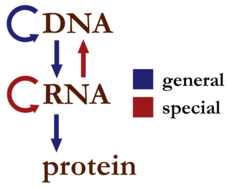The central dogma of molecular genetics
It has been valid since the sixties of the 20th century for all forms of life on Earth.
The basic information structure is a very stable, polymeric double helix DNA, completed by various proteins into a chromosome structure. Using enzymes and other chemical components, it is capable of self-reproduction' (DNA replication) using the complementary chain of 4 basic types of mononucleotides (pentose sugar triphosphates and purines (adenine(A), guanine(G) and pyrimidine (thymine T), cytosine(C))
Complementarity of both chains is ensured by hydrogen bridges:
- 2 between A and T,
- 3 between G and C.
The information function is provided by the genetic code (it is made up of the order, or sequence, of nitrogenous bases)
- Transcription: the transcription of DNA into an RNA structure ensures the transfer of genetic information from the chromosome structure to cytoplasmic organelles = ribosomes', where the synthesis of the final products of the genes - proteins takes place. (Translation).
The genetic code is triplet. Each of the 20 amino acids is encoded by one or more codons.
DNA transcription creates mRNA, which ensures translation on ribosomes, 4 types of rRNA (together with proteins, is the structural and functional essence of ribosomes) and tRNA ensures the transfer of individual amino acids to ribosomes + their binding into a polypeptide chain.
- Errors in DNA replication can occur (Mutation).
Shortened and simplified, the central dogma can be represented by the following scheme:
gene (DNA) → mRNA with a standard sequenceí → functional protein → normal function/character
'Reverse transcription, as we know it for example with retroviruses, is a process that enables reverse transcription - that is, literally reverse transcription of the RNA molecule back into DNA. With some viruses (RNA viruses) we can also observe RNA replication. These relatively specific mechanisms then complement the central dogma, as shown in the following figure:
Links[edit | edit source]
Related articles[edit | edit source]
- Translation in prokaryotes
- Genetic Code
- Genotype and its variability, mutation and recombination
- TRNA
Source[edit | edit source]
- OTOVÁ, Berta. Medical biology and genetics. 1. edition. Nakladatelství karolinum, 2008. ISBN 978-80-246-1594-3.

